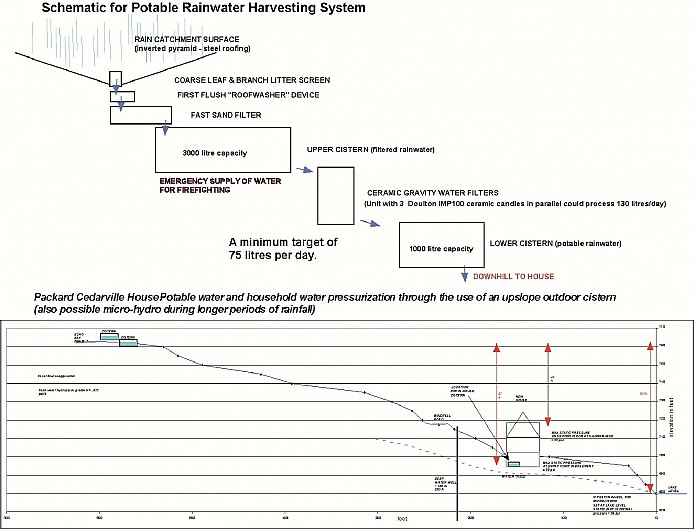Apart from breathable air, water is the most critical element for life on our planet. To be sure, water will become the most compelling issue for human civilization in this century. For this reason the technical portion of this information package on Solarhurst starts with water, even if locally it appears to be an insignificant problem (notwithstanding this year’s flooding). Most parts of Canada are blessed with an abundance of supply of potable water, through surface fresh water or un-depleted reservoirs of subsurface water. The Eastern Townships of Quebec are no exception.
Our attention to water conservation is therefore arguably philosophic, however minimizing the energy required to access potable water is most definitely pragmatic.
At Solarhurst we have drilled a deep well (345 feet) and appear to have encountered a healthy flow of non-sulphurous water. This will be our supply of fresh water during the freezing months of winter. In order to access that water and have reasonable (say 20-30 psi) pipe pressure at our taps, we will be compelled to use a deep submersible well pump and then a smaller more efficient inline pump. Both will consume energy (particularly at startup) to the tune of 300 kJ (kilojoules) per day.
During the non-freezing months we would like to avoid this energy consumption, and have decided to install a technology rarely used in Canada, but widespread in many parts of the world – rainwater harvesting. Rain is effectively derived from an immense natural distillation process (evaporation, then condensation) which by its very nature effectively purifies the water of any contaminants. Unless the rain subsequently falls through highly polluted air, it will fall as pure potable and very soft water. Contamination is picked up only when it hits a surface or is stored inappropriately. Both sources of contamination can be dealt with in a low (zero) energy fashion. Furthermore if the rain is captured and stored at a reasonably high elevation (with respect to the plumbing in the house) then gravity alone can supply adequate pipe pressure in the house, thereby eliminating the need for a pump.
We are fortunate at Solarhurst to have use of the Lot lying immediately north of our building lot. At its highest it has an elevation approximately 46 feet above our house’s highest plumbing point, and should yield a hydrostatic pressure of 20 psi. In the basement the hydrostatic will be 29 psi*. Flowing pressure will be lower due to frictional losses.
Various filtering devices (see illustration below) will render the rainwater safe. The water will be collected in a 4x6m inverted pyramid structure then retained in a 4000 litre cistern. It will then be transferred by gravity through a parallel arrangement of ceramic filters to a 1000 litre potable water holding tank. The 4000 litre cistern will supply water for outdoor gardening purposes and as a bonus it will serve as an emergency supply of water for fighting fires at any of the nearest 4 houses should that need arise (outside of winter).

*There is wonderful irony in acknowledging that Cedarhurst (the old house on the property torn down in 1946) used a cistern on the hill at the very same spot to supply the house with gravity- pressured water. There is very little new under the sun!
